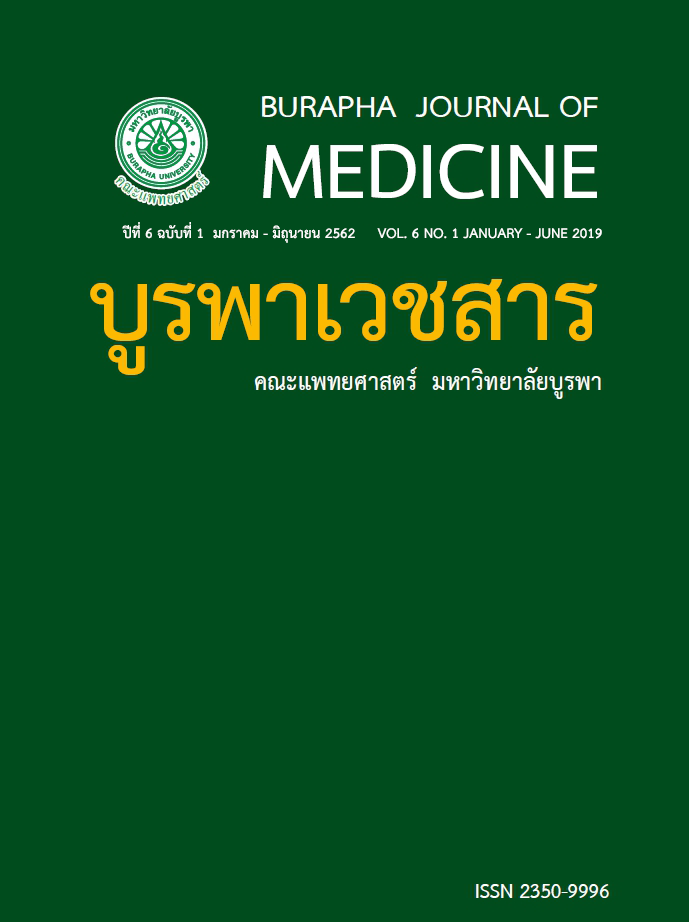ผลของการฝึกแบบอินเทอร์วาลที่มีต่อความสามารถสูงสุดในการนำออกซิเจนไปใช้และความแข็งแรงของกล้ามเนื้อของพนักงานที่ปฏิบัติงานในพื้นที่อับอากาศ
คำสำคัญ:
ความสามารถสูงสุดในการนำออกซิเจนไปใช้, การฝึกแบบอินเทอร์วาล, พื้นที่อับอากาศบทคัดย่อ
วัตถุประสงค์ เพื่อศึกษาผลของการฝึกแบบอินเทอร์วาลที่ระดับความหนักร้อยละ 70-75 ของอัตราการเต้นของหัวใจสูงสุด ที่มีต่อความสามารถสูงสุดในการนำออกซิเจนไปใช้ และความแข็งแรงของกล้ามเนื้อ ของพนักงานที่ปฏิบัติงานในโรงไฟฟ้า
วิธีการศึกษา วิจัยเชิงทดลองแบบกลุ่มเดียว กลุ่มตัวอย่างเป็นพนักงานของโรงไฟฟ้าบางปะกง จังหวัดฉะเชิงเทรา ที่ต้องปฏิบัติงานในพื้นที่อับอากาศจำนวน 28 คน ได้มาโดยวิธีเลือกแบบเจาะจง ทำการฝึกแบบอินเทอร์วาลที่ระดับความหนักร้อยละ 70-75 ของอัตราการเต้นของหัวใจสูงสุดเป็นเวลา 3 นาทีสลับกับช่วงพัก 3 นาที สัปดาห์ละ 3 วัน เป็นเวลา 8 สัปดาห์ จำนวนเซตในการฝึก สัปดาห์ที่ 1-4 ฝึก 5 เซต รวมเวลาการฝึกวันละ 30 นาที สัปดาห์ที่ 5-8 ฝึก 6 เซต รวมเวลาการฝึกวันละ 36 นาที ตัวแปรที่ศึกษาคือ ความสามารถสูงสุดในการนำออกซิเจนไปใช้ (ทดสอบด้วยวิธี Astrand-Rhyming Test) และ ความแข็งแรงของกล้ามเนื้อ (ทดสอบด้วยวิธีการวัดแรงบีบมือและแรงเหยียดขา) ข้อมูลที่ได้ก่อนและหลังการฝึกถูกนำมาวิเคราะห์หาค่าความแตกต่างที่ไม่เป็นอิสระต่อกัน (dependent t-test) นัยสำคัญทางสถิติกำหนดไว้ที่ 0.05
ผลการศึกษา ผลการวิจัยพบว่า ภายหลังการฝึกแบบอินเทอร์วาลเป็นเวลา 8 สัปดาห์ ค่าความสามารถสูงสุดในการนำออกซิเจนไปใช้ เพิ่มขึ้นอย่างมีนัยสำคัญทางสถิติโดยเพิ่มขึ้นจาก 26.72 (SD 5.88) เป็น 30.66 (SD 6.16) มิลลิลิตรต่อน้ำหนักตัวต่อนาที ความแข็งแรงของกล้ามเนื้อขา เพิ่มขึ้นอย่างมีนัยสำคัญทางสถิติโดยเพิ่มขึ้นจาก 1.77 (SD 0.58) เป็น 2.25 (SD 0.53) กิโลกรัมต่อน้ำหนักตัว
สรุป จากข้อมูลที่ปรากฏทำให้สรุปได้ว่า ภายหลังการฝึกแบบอินเทอร์วาลที่ระดับความหนักร้อยละ 70-75 ของอัตราการเต้นของหัวใจสูงสุดเป็นเวลา 8 สัปดาห์ สามารถพัฒนาค่าความสามารถสูงสุดในการนำออกซิเจนไปใช้ และค่าความแข็งแรงของกล้ามเนื้อของผู้ที่ต้องปฏิบัติงานในพื้นที่อับอากาศให้เพิ่มขึ้นได้
เอกสารอ้างอิง
2. Jenkins DG, Quigley BM. Endurance training enhances critical power. Med Sci Sports Exerc. 1992; 24: 1283-9.
3. ประทุม ม่วงมี. อินเทอร์วาล เทรนนิ่ง คู่มือการฝึกกีฬา. กรุงเทพฯ: อมรการพิมพ์; 2532.
4. Crawford MA, Foster C, Poole C, Bushey B, Wilborn C. Comparison of aerobic training
methods on VO2max, body composition and anaerobic power. Int J Exerc Sci. 2009; 2: S16, [Internet]. [accessed Feb 27, 2010]. Available from: https://digitalcommons.wku.edu/cgi/viewcontent.cgi?referer=https://scholar.google.co.th/&httpsredir=1&article=1017&context=ijesab
5. มณินทร รักษ์บำรุง. ผลของการฝึกวิ่งแบบต่อเนื่องควบคู่กับการฝึกวิ่งแบบอินเทอร์วาลที่มีต่อแอนแอโรบิคเทรชโฮล ปริมาณฮีมาโตคริต และความสามารถสูงสุดในการใช้ออกซิเจน. [วิทยานิพนธ์ปริญญาวิทยาศาสตรมหาบัณฑิต]. ชลบุรี: มหาวิทยาลัยบูรพา; 2546.
6. Malatesta D, Werlen C, Bulfaro S, Chenevière X, Borrani F. Effect of high-intensity interval exercise on lipid oxidation during postexercise
recovery. Med Sci Sports Exerc. 2009; 41: 364-74.
7. Foster C, Farland CV, Guidotti F, Harbin M, Roberts B, Schuette J, et al. The Effects of High Intensity Interval Training vs Steady State Training on Aerobic and Anaerobic Capacity. J Sports Sci Med. 2015; 14: 747-55.
8. Hetlelid JK, Herold E, Seiler S. Comparison of metabolic responses to high-intensity interval training in trained and well-trained males. Med Sci Sports Exerc. 2009; 41: 501.
8. วิรัตน์ สนธิ์จันทร์. ผลของการฝึกแบบอินเทอร์วาลในระดับความหนักและระยะเวลาต่างกัน ที่มีต่อ
ความสามารถสูงสุดในการนำออกซิเจนไปใช้ ปริมาณฮีโมโกลบิน สมรรถภาพเชิงแอนแอโรบิก และ
แอนแอโรบิกเทรชโฮล. [ดุษฎีนิพนธ์ปริญญาปรัชญาดุษฎีบัณฑิต]. ชลบุรี: มหาวิทยาลัยบูรพา; 2555.
9. Bayati M, Farzad B, Gharakhanlou R, Agha-Alinejad H. A practical model of low-volume high-intensity interval training induces performance and metabolic adaptations that resemble 'all-out' sprint interval training. J Sports Sci Med. 2011; 10: 571–576.
10. Gormley SE, Swain DP, High R, Spina RJ, Dowling EA, Kotipalli US, et al. Effect of intensity of aerobic training on VO2max.Med Sci Sports Exerc. 2008; 40: 1336-43.
11. Zacharogiannis E, Tziortzis S, Paradisis G. Effects of continuous, interval and speed training on anaerobic capacity. Med Sci Sports Exerc. 2003; 35: pS372.
12. Foster C, Farland C, Guidotti F, Harbin M, Roberts B, Schuette J, et al. The effects of high intensity interval training vs steady state training on aerobic and anaerobic capacity. J Sports Sci Med. 2015; 14: 747-55.
13. Nalcakan RG. The effects of sprint interval vs continuous endurance training on physiological and metabolic adaptations in young healthy adults. J Hum Kinet. 2014; 44: 97-109.
14. ธีรศักดิ์ อาภาวัฒนาสกุล. หลักวิทยาศาสตร์ในการฝึกกีฬา. กรุงเทพฯ: ส.เอเซียเพรส(1989); 2552.
15. MacDougall J, Hicks A, MacDonald J, Green H, Smith K. Muscle performance and enzymatic adaptations to sprint interval training. J Appl Physiol. 1998; 84: 2138-42.
16. Burgomaster K, Hughes S, Heigenhauser G, Bradwell S, Gibala M. Six sessions of sprint interval training increases muscle oxidative potential and cycle endurance capacity in humans. J Appl Physiol. 2005; 98: 1985-90.
17. Jacobs R, Flück D, Bonne T, Bürgi S, Christensen P, Toigo M, et al. Improvements in exercise performance with high-intensity interval training coincide with an increase in skeletal muscle mitochondrial content and function. J Appl Physiol. 2013; 115: 785-93.



